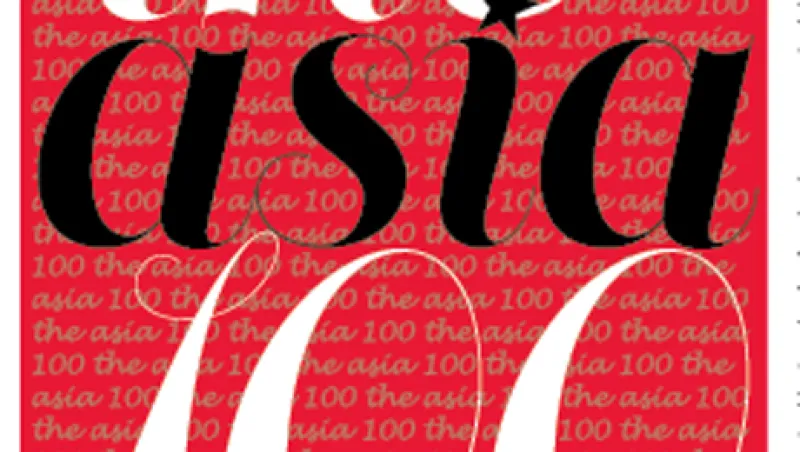If Asia were to take out an ad looking for investors, it might read something like this: “Ambitious, fast-growing region with clean balance sheet seeks growth-minded individuals willing to put up with market volatility.”
That description sounds a lot like the pitch that many asset managers in Asia have been making of late to pension schemes, insurance funds and holders of sovereign wealth. It has been working. By persuading Western institutions to give Asia a try, as well as taking on a growing number of Asian clients, fund managers experienced a more than 15 percent increase in assets for a second straight year, according to the 2011 Asia 100, Institutional Investor’s annual ranking of the region’s biggest money managers.
As of March 31, the 100 largest asset managers saw their Asia-based funds reach a record $13 trillion, up from $11.3 trillion 12 months earlier. Japanese insurers dominate the top of the ranking, led by Japan Post Insurance Co. (Kampo), with $1.16 trillion under management, and Nippon Life Insurance Group, with $654 billion in assets. Other top managers include large U.S. firms BlackRock, which had $438 billion of its $3.6 trillion in total assets invested in Asia, and State Street Global Advisors, with $375 billion of its $2 trillion in the region, and local players Macquarie Group of Australia ($252.6 billion) and China Life Asset Management Co. ($241.7 billion).
Much of the rise in Asia-based assets has been powered by investor interest in China, whose economy has performed well in the past year on traditional strengths such as robust exports of manufactured goods, relatively cheap labor and government infrastructure projects. China’s gross domestic product growth since the second quarter of 2010 has hovered between 9 percent and 10 percent, while emerging, export-led markets such as Taiwan and Singapore have logged double-digit quarterly economic expansion as they have come out of recession. Exports from much of Asia grew by more than 10 percent during the past six months.
Inflation ranged from 1.3 to 21 percent over the same period, depending on the country, averaging about 4 to 5 percent, while currencies have appreciated solidly against the battered U.S. dollar. Developing Asia, which includes all but a handful of modern countries, grew 8.2 percent last year, the Asian Development Bank found, and is expected to expand another 7.3 percent this year.
But China is putting the brakes on its economy, Japan is stuck in earthquake recovery mode, and Southeast Asia — where the pace of development varies sharply from country to country — is a grab bag of sweets and lemons. If the question is whether to invest in Asia, “the simple answer is yes, but you have to be careful,” says Hugh Young, managing director with Aberdeen Asset Management Asia, which had $68.8 billion in Asian assets as of March 31, up from $42.7 billion 15 months earlier.
“There are lots of pitfalls in this part of the world,” Young explains. “Asia is likely to remain strong for the next ten years, but it’s not a passport to making money.”
Investors outside Asia generally see the region as a place where they can grow assets fast while dodging the fallout from government debt problems plaguing both the U.S. and Europe. Asian governments learned to control debt after the region’s 1997–’98 crisis by keeping interest rates up and reining in fiscal spending while letting wages and assets run their natural courses. Testifying to a faith in Asia, many investors put assets in the region’s stocks and foreign exchange markets late last year, bypassing the U.S. after the Federal Reserve Board approved a round of quantitative easing.
Impacts of the recent debt crises may hurt Asian exports as U.S. and European consumers pull back, but no long-term aftershocks have rippled over thus far, fund managers say. “Investors looking to trim exposure to the West are expected to seek higher yields and safer destinations in the Asian region,” Radhika Rao and Connie Tse, regional economists with London-based market research firm Forecast, told II in a written statement. “Investors have shown an inclination toward economies that provide the best risk-reward ratio.”
China has particular allure because of its strong growth rate, which the ADB projects will be 9.6 percent this year and 9.2 percent in 2012, as well as a strengthening domestic economy. Monetary tightening could inhibit fast asset growth in the years ahead, though not reverse it, as Beijing seeks to head off any “hard landing,” warns Renee Hung, deputy chief investment officer with Hong Kong–based Value Partners Group, whose $8.9 billion of assets under management is invested entirely in Asia. New risks could surface because China “needs to do a lot of restructuring in the economy,” Hung adds. “Investors need to watch out for government policies — where they are in the tightening cycle and are they still pro-growth.”
Investors in Taiwan and Hong Kong, whose much smaller economies are linked to China’s, have braced for the potential impact of any revaluation of the Chinese renminbi or a sudden drop in high Chinese real estate prices, says John Chiu, executive vice president of Fuh Hwa Securities Investment Trust Co., a fund management firm based in Taipei.
Investor enthusiasm for China, however, has not been reflected in the performance of its stock market. The country’s signature Shanghai Stock Exchange composite index fell 14.3 percent in 2010 and was down a further 6.9 percent this year through August 25. Western institutions in particular have been wary of China’s accounting standards and the potential that listed companies, even those with strong earnings, may try to defraud investors. Aberdeen’s Young points to two events this year — a flap over Canadian timber holding company Sino-Forest Corp.’s accounting in China and a class-action lawsuit against Chinese calcium-carbonate maker ShengdaTech over financial reporting issues.
But most investors say the Chinese government’s broad goals are clear enough: more green laws, a shift from export reliance to a domestic market and avoidance of an asset bubble. They expect China to continue to enjoy economic growth in the high single digits.
Tracking that growth are Taiwan and South Korea, where technology giants such as HTC Corp. and Samsung Electronics have secured a prominent position in the world tech cycle, attracting investment as they come off decades of contract work to build their own brands. Taiwan’s export values hit a record $28.12 billion in July, and the Taiwan Stock Exchange weighted index rose 10.6 percent in 2010 only to give back all that gain and more this year, plummeting 17.4 percent through August 25. South Korea’s Kospi index was up 21.9 percent in 2010 but has fallen 14 percent this year. “We think the Korean and Taiwanese tech companies are catching up very strongly in the past few years compared to U.S. or Japanese counterparts, so we still see a promising trend,” says Value Partners’ Hung.
Japan, the traditional technology leader, has grappled with energy issues and overall economic malaise since the massive March 11 earthquake, which killed thousands and triggered nuclear power plant meltdowns. The Nikkei 225 index, which dipped 3 percent in 2010, was down 14.2 percent this year through August 25. Still, investors say that some of Japan’s better-established companies remain among Asia’s most attractive.
“Japan has some first-rate companies, and the country has some pretty good value,” says Aberdeen’s Young. “So it’s something one should look at closely, but the headlines are going to be pretty depressing.”
Assurances aside, Asia may appear largely enigmatic to institutions in Europe and North America because of the distance from home and a perception that things change fast there, says Julie Koo, Hong Kong–based Asia-Pacific head of institutional business for international banking giant HSBC Global Asset Management, which had $75 billion in Asia. She expects an “entire wall of institutional money” to reach Asia as Western institutions get more comfortable with doing business there.
Don’t expect a change overnight, says Paul Chan, Asia ex-Japan chief investment officer for Atlanta-based Invesco, which had $56.3 billion of its $616 billion under management invested in the region. “It will be ten to 15 years before Asia has a meaningful point of index,” says the Hong Kong–based CIO, referring to the lag time before Western institutions take the region as seriously as they do their own.
Regional volatility and the vast mixture of developed and developing markets in Asia concern some of those investors, who are on high alert this year as U.S. and European debt crises weigh on exporter-heavy, high-yield stock markets such as those in Taiwan and South Korea. Developing countries like Indonesia, Malaysia and Thailand are becoming more attractive because of their strong domestic markets, while others, such as Vietnam, are faltering under unexpected developmental pressures.
“Asia is not a homogeneous region,” Koo says. “It’s really a mixed bag, which makes doing business in Asia particularly challenging.”
Some institutions have learned to use instruments that control volatility risk. For example, as inflation looms as a problem for countries like Vietnam, investors have turned to inflation-linked bonds or commodity-based funds that resist consumer price hikes and even profit from them. An Asian short-duration bond fund offered by Aberdeen has also caught on with European and U.S. clients that want broad exposure to the region’s relatively strong currencies, Young says.
Asian institutions have also come out of the woodwork to hire fund managers as the region becomes more complex and they seek to spread their investments outside Asia — to markets in which their in-house staff members traditionally lack expertise. The fund management business itself has grown slightly in Asia during the past year. Listed equities and fixed income remain popular with local investors, but firms based in developed markets such as Japan, Singapore and South Korea have sought to protect their portfolios through diversification by increasing their allocations to hedge funds and private equity. “These three [countries] are under the radar but are increasing in terms of volumes,” says Antoine Broquereau, director of alternatives with Société Générale Corporate & Investment Banking in Singapore.
The financial crisis has prompted regulators in Hong Kong and Singapore to require that fund managers disclose more information to client institutions and use plainer language to explain any investment risks, says Paul Hopkins, manager of Barclays Capital Fund Solutions in Asia. Australia is working on similar regulations to protect institutional investors, he says, adding: “I think the aim is to allow investors to walk away with a sense of ‘I know what I’m getting.’”






